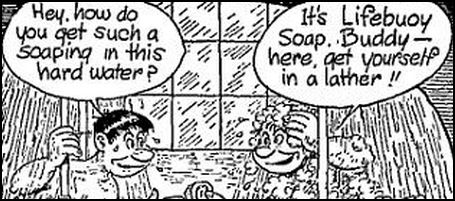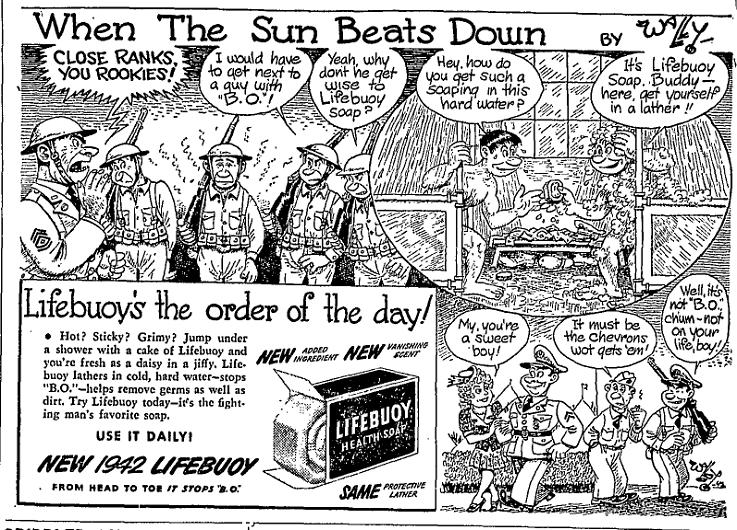
This 1942 ad for Lifebuoy soap is a great example of shifts in collective cultural awareness of homosexuality. From a contemporary U.S. perspective, where most of us have heard homophobic jokes about not dropping the soap in the shower, two men showering together (even or especially in a military context) and using language like “hard” and “get yourself in a lather” is undeniably a humorous reference to gay men.
I think, however, that this was not at all the intention in 1942, where the possibility of men’s sexual attraction to other men wasn’t so prominent of a cultural trope. It simply wasn’t on people’s minds as it is today. Accordingly, the ad seems to be a simple illustrated recommendation, complete with a nice heterosexual prize at the end.

From Vintage Ads.

Comments 34
T — January 27, 2011
"Over the years I got to be quite a connoisseur of soap. My personal preference was for Lux, but I found Palmolive had a nice, piquant after-dinner flavor - heady, but with just a touch of mellow smoothness. Lifebuoy, on the other hand... "
The original formula is only available as an import from the UK. If you find it on a non-specialty store shelf in the US, it will have 'modern' perfumes etc.
Alan B — January 27, 2011
I don't understand your "homophobic joke" comment. I know this is a little tangential, but I'm confused by the equivocation of homophobia with preservation of personal safety. Being unwilling to have homosexual intercourse, consensual or not, does not make a person homophobic.
As I understand it, "don't drop the soap" isn't meant to suggest that gay men can't control themselves when they see naked men. Rather, it's very specific to the situation of a prison shower room, where homosexual rape is (supposedly) more common.
Sorry if I'm reading too much into your comment, I'm just curious.
Xavier — January 27, 2011
How quaint that the ad says it has a "new added ingredient" and leaves it at that.
Andrew — January 27, 2011
Doubles-entendres and sly subtexts related to homosexuality weren't really all that uncommon in the early 20th c. - it's quite stunning how many ways the topic emerged quietly in prewar cinema if you know how to spot it. But a lot of cultural norms - including men bathing, bedding, or being nude together - took a more decisive shift in the decades after this ad. In contemporary America, almost any suggestion of intimacy or exposure between men is now read - most often incorrectly - as homoerotic, largely because of its absence from any other recognized context.
In other words, this ad is probably jarring to western eyes in 2011 for the same reasons as the sight of hetero men in the Middle East holding hands and kissing each other's cheeks.
Astraea — January 27, 2011
It simply wasn’t on people’s minds as it is today.
I think you mean that homosexuality wasn't on straight people's minds.
Aylon — January 27, 2011
I would have to disagree with your dating of the presence of homophobia/homosexuality on the cultural consciousness. Homosexuality became a medical concern (was a medical construction) in the late 19th century and ever since then homophobia has been in the popular consciousness in various degrees of intensity. For instance, In the 1930s gays were blamed for the crash of stock market because of their excessive lifestyles and licentious ways. In the 1920s gays were a target of social purity and marital hygiene campaigns. Scholars have shown how the Boy Scouts of America was created at the turn of the century because of an anxiety over the spread of effeminacy, which was linked to homosexuality. So it's not at all that homophobia wasn't a cultural fact at the time; it certainly was part of the collective cultural consciousness.
What you miss in the analysis of this ad is its spatial context. This ad is taking place in a hyper-masculinized space, the army. Hyper-masculinization manages to dismiss claims of homosexuality, since homosexuality was (and still is) seen in gendered terms, i.e. gayness is equivalent to femininity.
Lola — January 27, 2011
My question is: are we more or less homophobic for recognizing the homosexual undertones to the ad in this day and age?
On one hand, the homosexual undertones were not being observed because being aware of such things was not part of the "collective cultural consciousness."
On the other hand, we're aware that gays exist nowadays, so we see the undertones, but this ad would lead quite a few people to fits of histeria.
WG — January 27, 2011
I've got to be honest here. I just don't see what you are all talking about.
-There are no homosexual acts depicted.
-There are no solicitation of homosexual acts.
-There is no implication of homosexuality at all, in fact it is just to the contrary.
If the argument is that this type of ad wouldn't fly nowadays because of homophobia, I can kind of see that point, but that is a stretch. I think an equal argument could be said that only homophobes recognize anything homosexual about the ad.
I just don't see the "joke" that everyone is talking about.
Are we all reading too much into a cartoon about a stinky G.I.?
SamR — January 27, 2011
Somehow I didn't get any gayness out of the comic. It just seemed like typical army shower talk.
dirtybird — January 27, 2011
I really didn't get the "reference to gay men" from that comic. Using language like "hard" in the sense of "hard water" in an ad for soap just doesn't strike me as suggestive. IDK.
Sex History Link Round-Up – Silent Porn Star — January 28, 2011
[...] homophobic jokes about soap dropping in the shower via vintage [...]
The Promiscuous Reader — October 10, 2011
It would be nice if you were to indicate who had been reading gayness into this cartoon. Otherwise you're just addressing a straw man. And I can't help wondering *which* "contemporary US perspective" you have in mind: a clueless straight perspective? a homophobic straight perpsective? a prurient gay perspective? There isn't just one "contemporary US perspective."
MO — October 16, 2011
If anything, it might have a reference to masturbation. But I agree with the others, I don't see any "gay overtones" here.